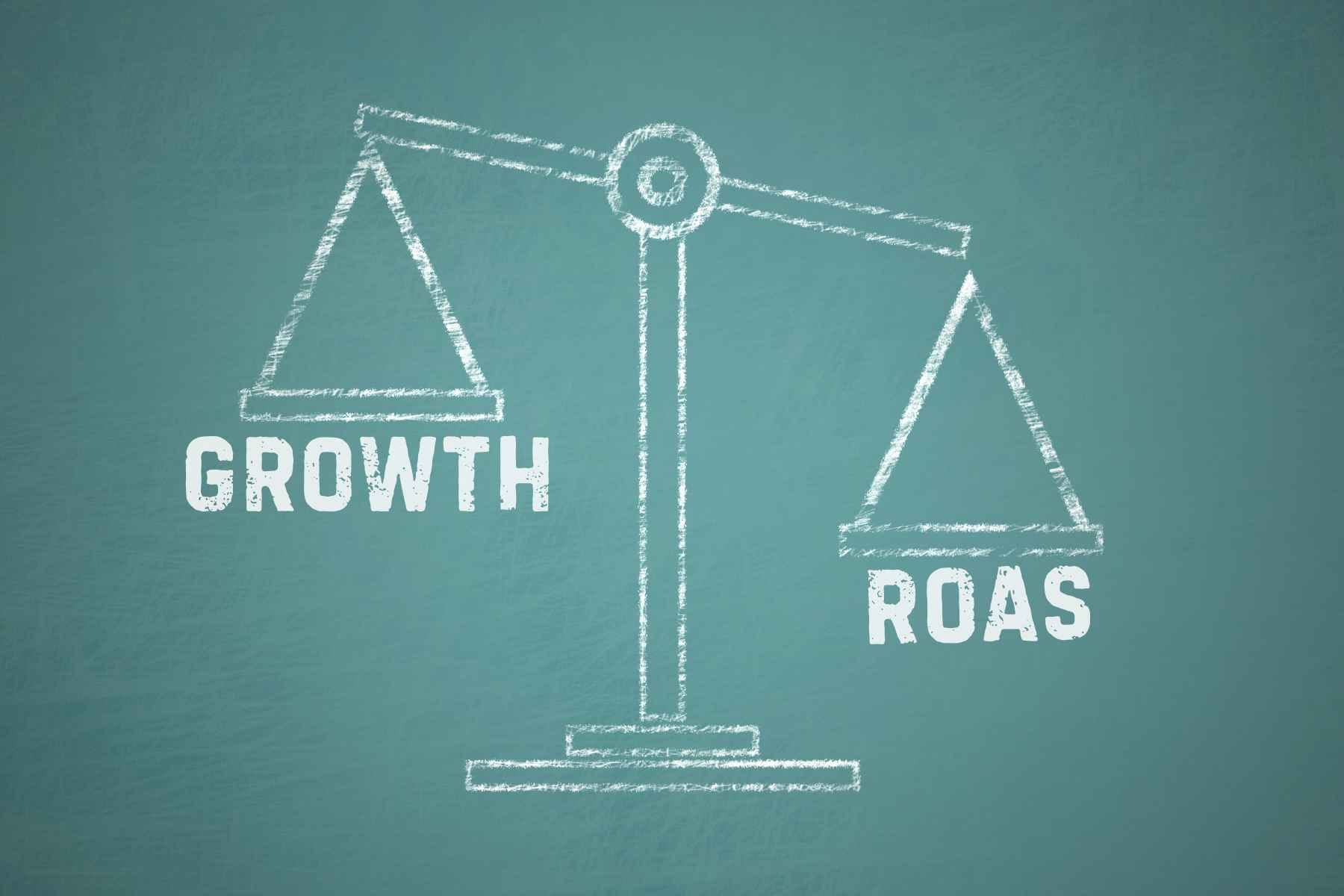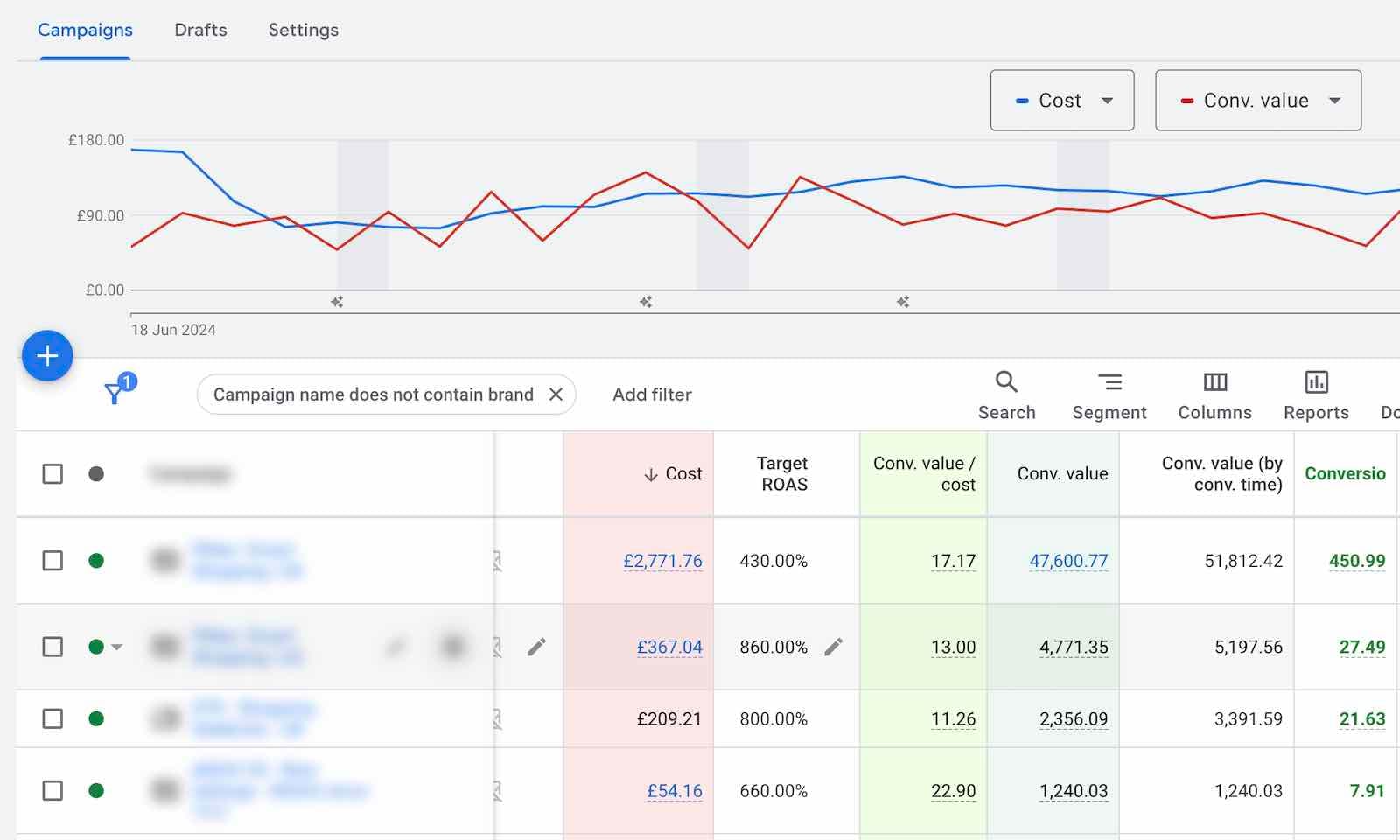

We all want more. More revenue, more profit, more awareness and more visibility.
If you are running performance marketing campaigns, you will know that more of one thing often means less of the other. So what should you be focusing on the most, and how should you direct your Google Ads manager to stir your account?
Return on ad spend, often called ROAS, is the result of the total revenue created, divided by the cost. ROAS is often confused with ROI (return on investment) but ROI should ideally include all the costs and not just the money spent on ads.
ROAS is calculated by this simple formula: Sales revenue / Cost = ROAS. In Google ads the sales revenue is labelled Conversion Value, so the column for ROAS is Conv. Value / Cost.
Every business should know their break even ROAS. This should take into account profit margin for product sales and all other costs. If your break even ROAS is x3 or 300%, this means that for anything below that you lose money, and for anything over it you start making a profit.
ROAS performance can also project revenue from a given campaign. For example: If a campaign has had a steady ROAS of x5 or 500%, then it will make $5 for every $1 spent on ads as you scale it, in theory.
The simple answer? Everything!
This includes demand for your products, competition, your reviews, reputation, how well optimised your website or app are, general market trends and of course if your Google Ads account is well optimised.
Depending on all these elements, you’ll find most account performances floating around their baseline industry ROAS, which is dictated by the competition, margins and CPCs.
You can of course tweak and optimise campaigns for more efficiency, but aiming for the highest ROAS isn’t necessarily the best strategy for every business.


Each business will float around a native ROAS. In this case, our client's high ROAS is typical of their industry and their target is over 700%, which is higher than most.
Though ROAS and revenue are not directly opposed, more of one usually means less of the other.
For a higher return on ad spend, you typically need lower bids and more selective targeting. Your campaigns will be more efficient (higher ROAS) but the overall volume could be lower.
For more revenue, you typically want more reach with wider targeting and higher bids. Any gains in volume could come at the cost of reduced efficiency.
By default more revenue means lower ROAS. Aiming for higher ROAS limits volume. This isn’t always the case and there are smart ways to scale campaigns efficiently (we’ll talk about that later) but it’s important to understand this basic relationship.
Imagine that you’re targeting a bunch of keywords which are all relevant for your business. Your competitors are also targeting the same keywords because they’re not stupid and have figured out where most of the conversions are coming from.
Hypothetically, let’s imagine you’re paying $1 per click and reaching 50% of the customers searching. If you want to reach more customers you’ll have to increase your bids and pay more per click.
This will result in more clicks and a bigger market share, but you’ll also pay more per click and as a result spend more. Your campaign will be less efficient as each sale will cost more, but you will gain more sales.
And it works the other way around of course. Lower bids (say 20% less) will result in cheaper conversion but less impressions, clicks and conversions.
Automated bidding works in the same way, there is still an auction with bids resulting in a cost per click. You’re directing Google with a target, your desired CPA or ROAS and Google adjust the bids up or down for you.
For example, if you reduce your target ROAS in an automated campaign, Google will increase the bids so that you appear more often. As a result you’ll see more impressions and clicks, but conversions will cost more as you’re paying more per click.


Whatever your bid strategy settings in Google Ads may be, the end result is always a higher or lower CPC bid in the ad auction.
While the basic relationship between the two means compromising one in favour of the other, there can be ways to grow both, or at least maintain your ROAS as you scale up your campaigns.
In a nutshell, this would involve finding the efficiencies and scaling where your spend is best invested.
Typical examples in an ecommerce account would be focusing on winning products that can scale up without losing ROAS. You can push more budget towards them with little or no loss in ROAS.
In a search campaign, this could involve finding underserved keywords with great performance but not enough volume.
You can scale the best performing elements in the account, reduce spend on lower and performers and increase overall effectiveness.
When you’ve optimised your campaigns as much as you can, you’ll end up with the real life ROAS dictated by your products, industry, margins and competition.
Assuming that ROAS is above target, you should try and scale revenue as much as possible. In this balancing act between ROAS and revenue, the sweet spot is where you hit the highest profit for your account.
If you push for higher ROAS you’ll see diminishing returns with less overall volume and less profit. If you reduce your ROAS target, volume might grow but you might not be profitable.
The sweet spot is where you are maximising both volume efficiency for your business.
The clearer you can be as a business about priorities and goals, the better you’ll be able to achieve these goals with efficient campaign management. While all businesses want more sales, not all have specific goals and priorities to work towards.
A good starting point would be figuring out your break even ROAS and establishing priorities. Are you focused on revenue growth or profit? Have clarity and communicate this to your PPC manager. As long as there’s clarity about the direction, they should be able to stir the account towards your destination.
We're a London based Google Ads agency working on eCommerce marketing as well as lead generation PPC. With over 10 years of experience working with brands to grow revenue profitably.
Odi Caspi - founder

